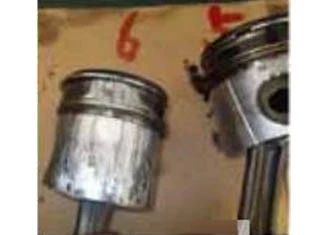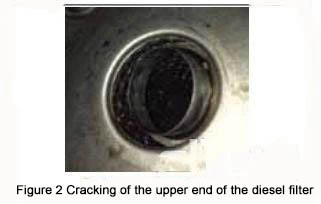Find the fault location
First, the exhaust pressure when measuring the oil filling port is 2.54 kPa.
Secondly, check the oil level of the oil and the liquid level of the coolant. Check that the engine oil and diesel filter used in the machine are all from regular manufacturers.
Again, check that the air filter is intact, there is no air leak in the air intake, and there is no dust. Finally, after dismantling the diesel engine body, it was found that the VI cylinder liner was pulled, the piston had severe adhesive wear, and the cylinder cooling nozzle was blocked by colloidal foreign matter. As shown in Figure 1.
Figure 1 Piston damage
After disassembling the oil filter, it was found that there were debris such as debris on the surface of the filter paper, which indicated that the filter element played a certain filtering role. Further inspection revealed that the filter paper had collapsed inward, the iron upper end cover of the fixed filter paper was deformed, and the positioning flange hole of the upper end cover was cracked and disengaged from the filter paper, as shown in FIG. 2 .
According to the analysis, after the oil filter is cracked, part of the oil is not filtered and passes directly from the crack. The impurities in this part of the oil enter the diesel engine lubrication system, and the VI cylinder piston cooling nozzle is blocked, causing the VI cylinder piston to be cooled without heating, resulting in the cylinder and the cylinder barrel pulling phenomenon.
Cause analysis
We examined and analyzed the causes of the cracking of the upper end cap of the oil filter element.
(1) Check the upper end cover rounded corners
We took five samples of this type of oil filter for dissection and measured the transition fillet at the bend of the upper end cap of the oil filter. The measurement results show that the transition cap of the upper end cover of this type of oil filter meets the requirements of the drawings.
(2) Checking chemical division
We sampled the end cap of the damaged oil filter near the crack, and after derusting, polishing, and cleaning the sample, the chemical composition was analyzed by a spectrum analyzer. The inspection results show that the material of the upper end cover meets the national standard.
(3) Hardness test
We sampled the upper end of the oil filter near the crack and other parts, and placed the sample on a microhardness tester. The results show that the average microhardness near the crack is 157 HV, and the average microhardness of other parts is 139 HV. The hardness of the cracked part is greater than the hardness of other parts, indicating that there is a cold hardening phenomenon in the arc portion during bending.
(4) Microscopic observation of crack
The crack propagation zone and the instantaneous fracture zone of the upper end cap of the cracking oil filter were sampled, and the sample was polished, derusted, and cleaned, and then observed under an electron scanning microscope. As a result, fatigue fringing characteristics were observed in the crack propagation zone, and dimple crack characteristics were observed in the instantaneous fracture zone. Both fatigue fringes and dimple cracks exhibit fatigue fracture characteristics.
(5) Analysis of installation methods
The upper end cap of the oil filter has obvious fatigue fracture characteristics, indicating that the oil filter is subjected to alternating load. The oil filter is installed on a cantilever end of a 5mm fixed bracket. We install vibration probes on the diesel engine and the oil filter to measure the vibration of the oil filter when the diesel engine is working. After measurement and comparison, the actual vibration acceleration of the oil filter is much larger than the vibration acceleration of the diesel engine, and the maximum acceleration peak even reaches 14g. This acceleration has exceeded the capacity of the oil filter design.
It can be seen from the above detection that the upper end cap of the oil filter is cracked for the following two reasons:
First, the upper part of the oil filter has a cold work hardening phenomenon when the upper end cover is bent. The stress concentration is caused by the difference in hardness between the cold hardened portion and the surrounding hardness.
Second, the installation position of the oil filter is unreasonable, causing the filter element to vibrate too much and the additional stress is too large.
improvement measures
The oil filter can be adjusted to the installation position, and the structural form of the oil filter fixing plate can be changed, that is, the thickness of the oil filter fixing bracket is increased to 8 mm. After increasing the thickness of the fixed bracket, the test oil filter vibration acceleration is less than 10g, which satisfies the installation requirements of the oil filter.
Post time: Aug-15-2019






